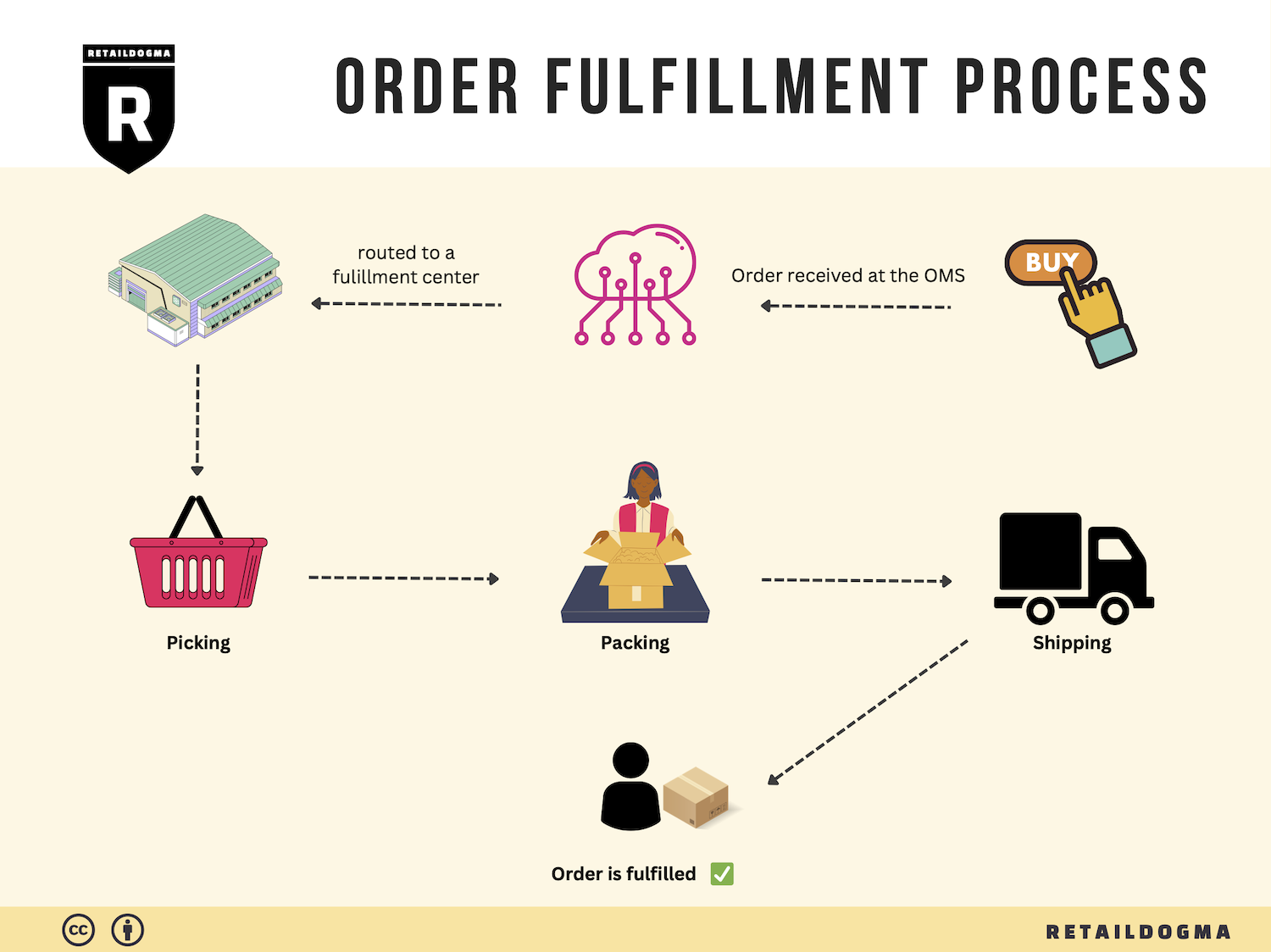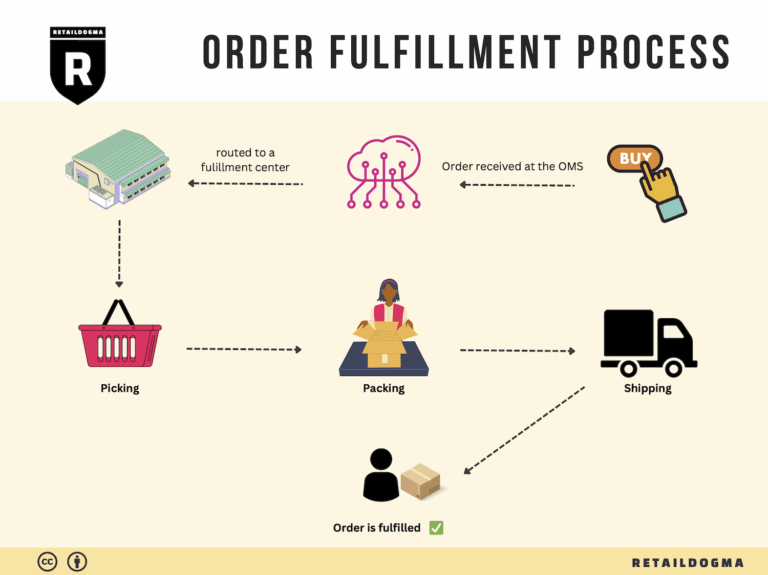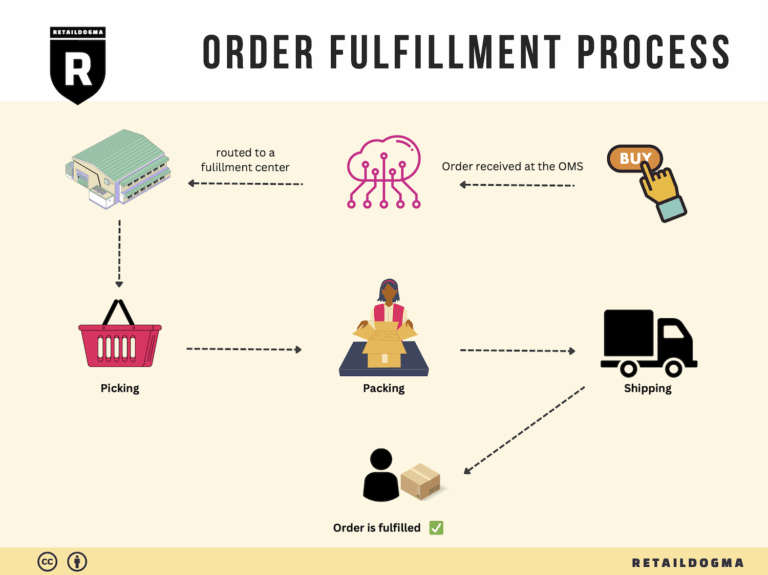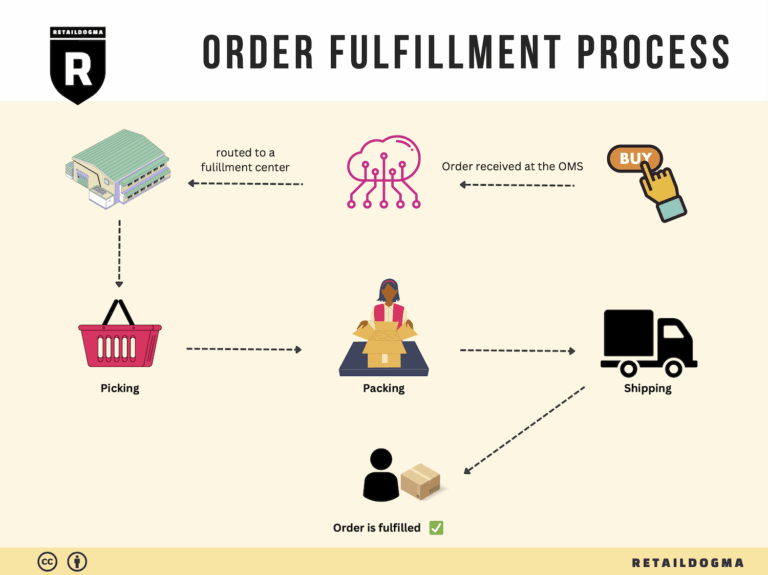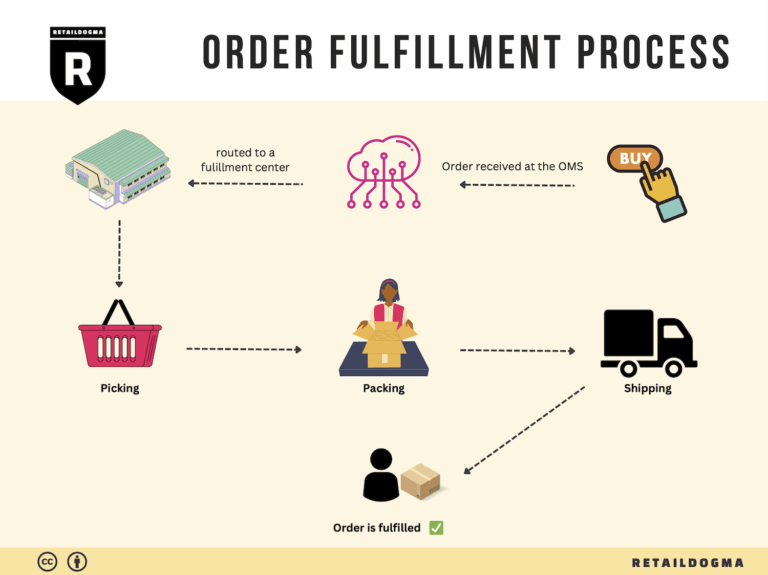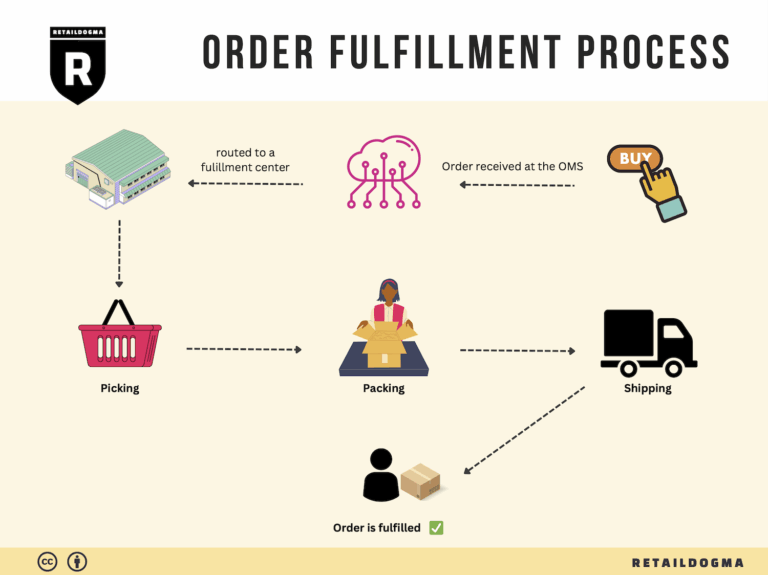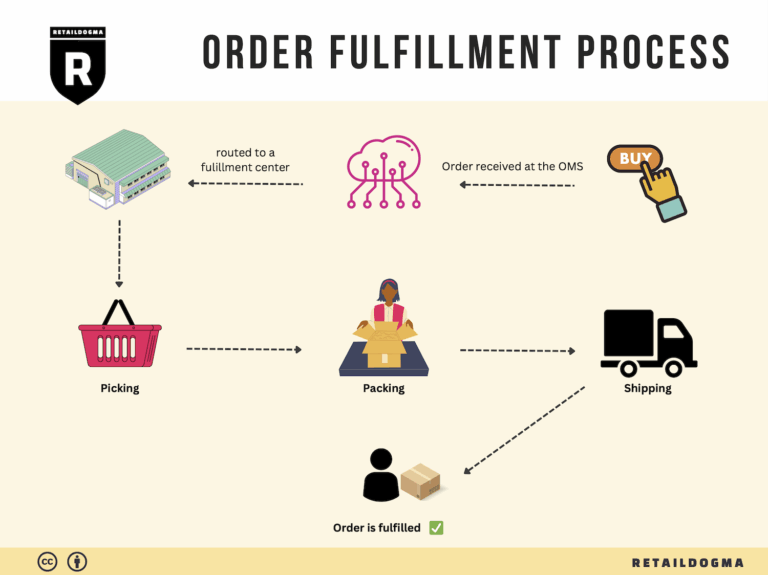What Is A Fulfillment Center? A Complete Guide (2025)
What is E-commerce Fulfillment? An Introduction for Growing Businesses
As your online business begins to grow, you may find yourself overwhelmed with the complexities of packing and shipping orders. The excitement of increased sales can quickly turn into stress when you’re faced with the logistics of fulfilling those orders efficiently. This is where e-commerce fulfillment comes into play—essentially, it’s the process of getting a product from your inventory to your customer’s doorstep.
E-commerce fulfillment encompasses a wide range of activities, including inventory management, order processing, packing, shipping, and handling returns. For many growing businesses, managing these tasks in-house can become a logistical nightmare, diverting valuable time and resources away from core operations like marketing and customer engagement. Understanding the fulfillment landscape is crucial for scaling your business without sacrificing customer satisfaction.
In this guide, we will explore the various models of e-commerce fulfillment that can help streamline your operations. You will learn about Third-Party Logistics (3PL) providers and Amazon’s Fulfillment by Amazon (FBA) services, both of which offer unique advantages depending on your business needs. We will break down the core services offered by fulfillment partners, including storage, picking, packing, and shipping, so you can better understand what to expect.
Choosing the right fulfillment partner is a pivotal decision that can impact your business’s growth trajectory. We will provide insights on how to evaluate potential partners, taking into account factors like location, technology, scalability, and customer service. Additionally, we will discuss pricing structures commonly used in the industry, helping you to forecast costs accurately and make informed budgeting decisions.
The goal of this guide is to empower you with the knowledge and tools necessary to make smart logistics decisions. By understanding e-commerce fulfillment and its various components, you can position your business for success, ensuring that your customers receive their orders promptly and accurately. This not only enhances customer satisfaction but also frees you to focus on what you do best: growing your brand. Let’s dive in and explore how efficient fulfillment can be a game-changer for your business!
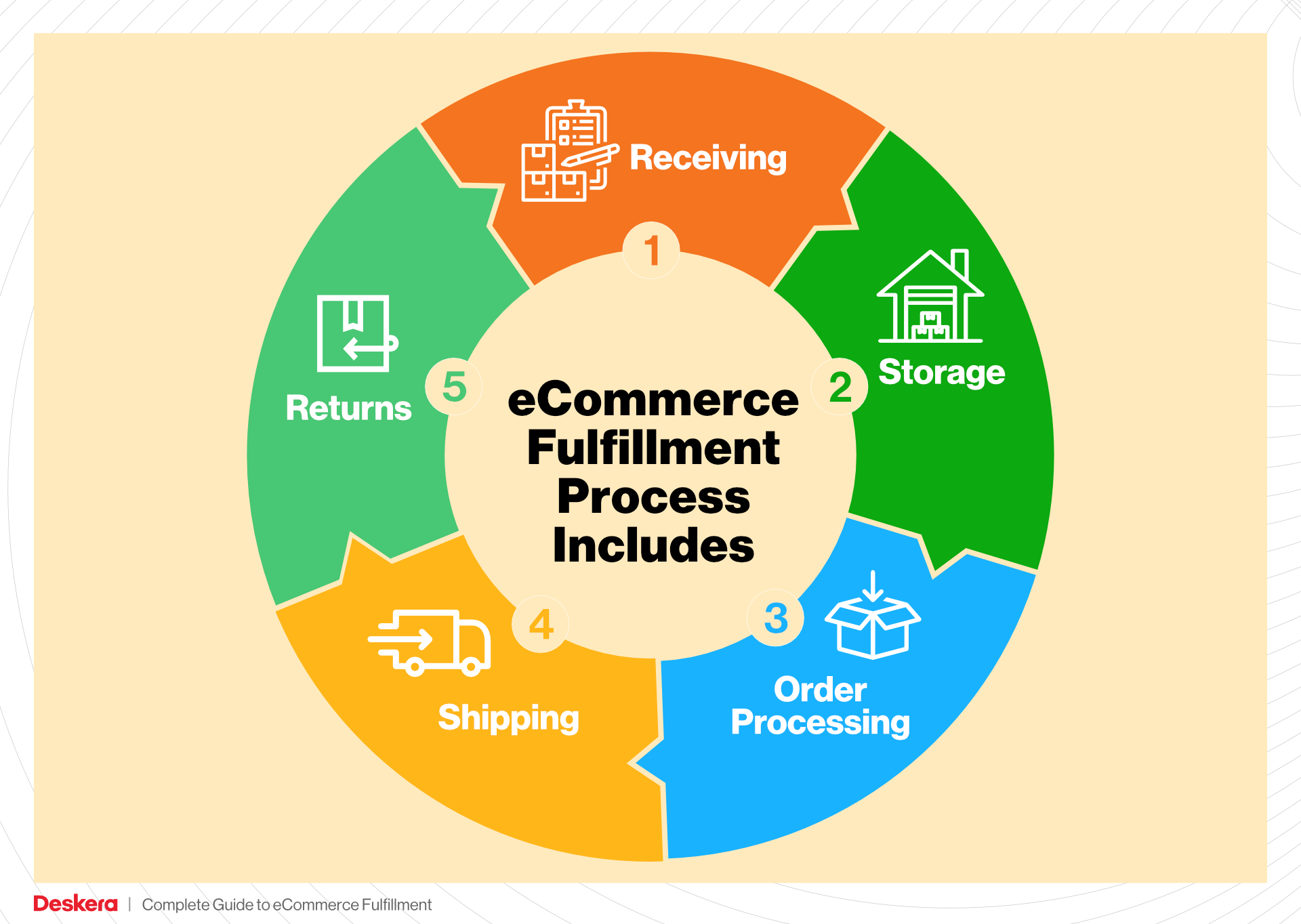
What You’ll Learn In This Guide
- What is E-commerce Fulfillment? An Introduction for Growing Businesses
- The Order Fulfillment Process: From ‘Buy’ Button to Customer’s Door
- Comparing Fulfillment Models: In-House vs. 3PL vs. Dropshipping
- A Deep Dive into Amazon FBA: Pros, Cons, and Who It’s For
- Core Services Offered by Fulfillment Centers
- How to Choose a Fulfillment Partner: A 6-Point Checklist
- Understanding Fulfillment Pricing: A Breakdown of Common Fees
- Frequently Asked Questions (FAQs) about Fulfillment
- Conclusion: Is Outsourcing Fulfillment the Right Move for Your Business?
- Important Disclaimer
The Order Fulfillment Process: From ‘Buy’ Button to Customer’s Door
1. Receiving Inventory
The first step in the order fulfillment process is receiving inventory at the fulfillment center. This involves checking incoming shipments against purchase orders to ensure the correct items and quantities are received. Each item is assigned a Stock Keeping Unit (SKU), a unique identifier that allows for efficient tracking and management within the warehouse.
Importance: Properly receiving inventory is crucial for maintaining accurate stock levels, preventing stockouts, and ensuring that customers receive the correct products. Errors at this stage can lead to significant downstream issues, including customer dissatisfaction and increased operational costs.
Key Term: SKU (Stock Keeping Unit) – A unique identifier for each product, essential for tracking inventory levels and sales.
2. Warehouse Storage
Once inventory is received and verified, it is stored in designated areas within the fulfillment center. Effective storage strategies are essential, and items are typically organized based on their SKU, size, and demand frequency. High-demand items may be placed in easily accessible locations, while less frequently sold products can be stored further away.
Importance: Efficient warehouse storage optimizes space and enhances the speed of order fulfillment. By strategically placing products, businesses can reduce the time it takes to locate and retrieve items during the picking process, ultimately improving overall operational efficiency.
Key Term: ABC Analysis – A method of categorizing inventory based on importance and turnover rates, guiding storage decisions.
3. Order Picking
When a customer places an order, the fulfillment process moves to order picking. This involves selecting items from their storage locations based on the order details. Fulfillment centers often utilize technology, such as pick lists or handheld scanners, to streamline this process and ensure accuracy.
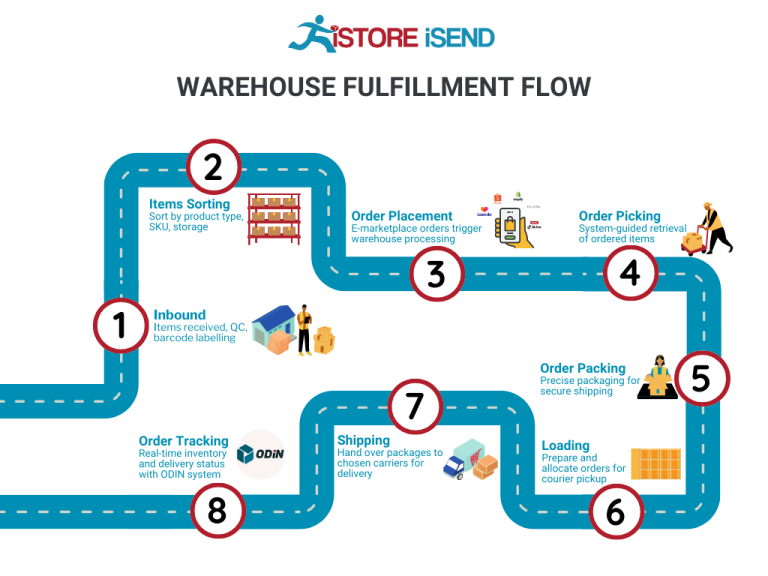
Importance: Order picking is a critical step that directly impacts order accuracy and customer satisfaction. Efficient picking reduces the time it takes to fulfill orders, which can lead to faster delivery times and improved customer experiences.
Key Term: Pick List – A document or digital tool that lists the items and their locations for fulfillment center staff to efficiently gather products.
4. Order Packing
After the items have been picked, they are moved to the packing station, where they are prepared for shipment. This step includes verifying the items against the order, selecting appropriate packaging materials, and ensuring that products are securely packed to prevent damage during transit. Businesses often leverage packing slips, which detail the contents of the package.
Importance: Proper packing is vital for protecting products during shipping and ensuring that customers receive their orders in good condition. Efficient packing processes can also reduce shipping costs by optimizing package sizes.
Key Term: Packing Slip – A document included with the shipment that lists the items being sent, providing clarity for both the customer and the fulfillment center.
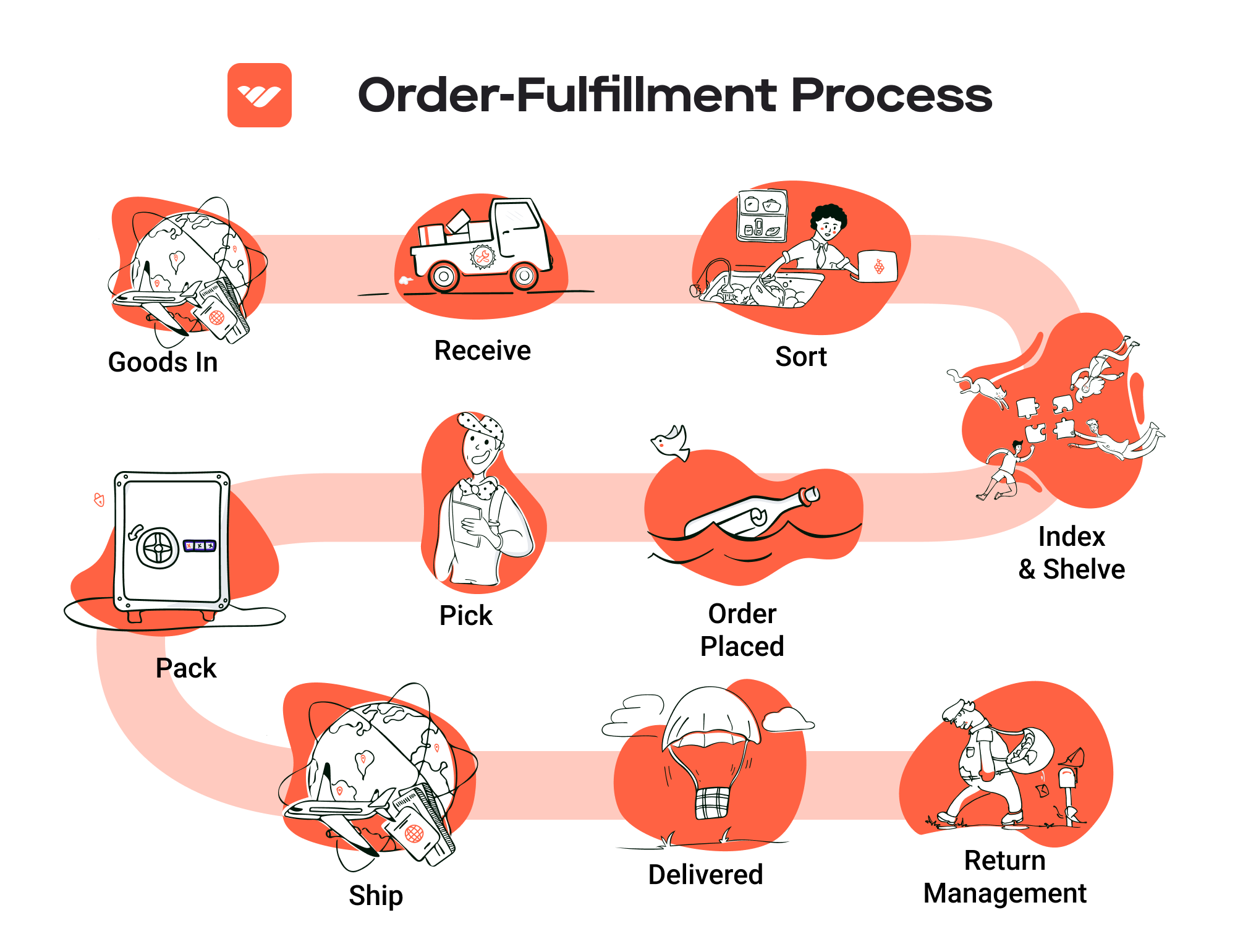
5. Shipping & Delivery
The final step in the fulfillment process is shipping the packed orders to customers. This involves selecting the best shipping carrier based on cost, delivery speed, and destination. Fulfillment centers often integrate with shipping software to automate label creation and tracking updates.
Importance: Timely and accurate shipping is crucial for customer satisfaction. Providing reliable tracking information enhances the customer experience and builds trust in the brand. Additionally, optimizing shipping routes and methods can significantly reduce costs and improve delivery times.
Key Term: Last-Mile Delivery – The final step of the shipping process where the package is delivered from a transportation hub to the final destination, which is often the most complex and costly part of logistics.
By understanding and optimizing each of these steps, e-commerce businesses can enhance their order fulfillment processes, leading to improved efficiency, reduced costs, and increased customer satisfaction. Implementing best practices in these areas is essential for scaling operations and remaining competitive in the ever-evolving e-commerce landscape.
Comparing Fulfillment Models: In-House vs. 3PL vs. Dropshipping
Fulfillment Model Comparison
| Model | Who Handles Inventory | Best For (Business Stage) | Key Advantage | Key Disadvantage |
|---|---|---|---|---|
| In-House Fulfillment | Business Owner | Established Businesses | Full control over inventory and processes | High operational costs and resource demand |
| Third-Party Logistics (3PL) | 3PL Provider | Growing Businesses | Scalability and reduced overhead costs | Less control over inventory and processes |
| Dropshipping | Supplier | Startups and New Brands | Low initial investment and risk | Lower profit margins and potential supplier issues |
In-House Fulfillment
In-house fulfillment involves managing the entire inventory, warehousing, and shipping process internally. This model is often adopted by established businesses that have a steady volume of orders and require a high degree of control over their logistics. By handling inventory on-site, companies can implement personalized packaging, quality control, and faster response times to customer inquiries. However, the key disadvantage of this model is the high operational costs associated with maintaining a warehouse, hiring staff, and managing logistics. Businesses must also invest in technology and infrastructure to effectively manage their supply chain, which can be a significant barrier for smaller companies or those just starting out. Overall, while in-house fulfillment offers control and flexibility, it requires substantial resources and commitment.
Third-Party Logistics (3PL)
Third-party logistics (3PL) is a model where businesses outsource their logistics operations to specialized providers. This is an ideal solution for growing businesses that need to scale their operations without the burden of managing logistics themselves. 3PL providers handle everything from warehousing and inventory management to order fulfillment and shipping. The primary advantage of using a 3PL is scalability; businesses can easily adjust their logistics services according to demand fluctuations without incurring the fixed costs of an in-house operation. However, a potential drawback is the loss of control over inventory management and shipping processes. Businesses must rely on the 3PL provider to maintain quality standards and ensure timely deliveries, which can lead to inconsistencies if not managed carefully. Overall, 3PL is an effective option for businesses looking to expand without the significant investment associated with in-house fulfillment.
Dropshipping
Dropshipping is a fulfillment model where businesses sell products they do not keep in stock. Instead, when a customer makes a purchase, the order is forwarded to a supplier who then ships the product directly to the customer. This model is particularly suitable for startups and new brands as it requires minimal upfront investment and eliminates the risks associated with holding inventory. The key advantage of dropshipping is that it allows businesses to offer a wide range of products without the burden of managing stock or logistics. However, this model has its disadvantages, such as lower profit margins and potential issues with supplier reliability. Since businesses rely on third-party suppliers for product quality and shipping, any delays or quality issues can reflect poorly on the brand. Additionally, businesses have less control over inventory levels, which can lead to stockouts or over-promising delivery times. Despite these challenges, dropshipping remains an attractive option for entrepreneurs looking to enter the e-commerce space with limited resources.
In summary, each fulfillment model has its unique advantages and disadvantages, making them suitable for different business stages and operational needs. By understanding these differences, e-commerce business owners can make informed decisions that align with their growth strategies and logistical capabilities.
A Deep Dive into Amazon FBA: Pros, Cons, and Who It’s For
Understanding Fulfillment by Amazon (FBA)
Fulfillment by Amazon (FBA) is a service provided by Amazon that allows sellers to store their products in Amazon’s fulfillment centers. Amazon takes care of storage, packaging, and shipping of these products directly to customers, as well as managing customer service and returns. This service enables sellers to leverage Amazon’s extensive logistics network, providing a seamless shopping experience for customers.
When a customer places an order for a product fulfilled by FBA, Amazon handles the entire process—from picking and packing the product to shipping it out and managing any post-sale customer service inquiries. Sellers are charged fees for these services, which vary based on the size and weight of the items stored and sold.
How FBA Works
-
Set Up an Amazon Seller Account: To use FBA, you need to create an Amazon Seller account. This can be done through the Amazon Seller Central portal.
-
List Your Products: Once your account is set up, you can list your products on Amazon. When you select FBA, you indicate that Amazon will handle the fulfillment of those products.
-
Ship Products to Amazon: After listing your products, you will need to ship them to Amazon’s fulfillment centers. Amazon provides guidance on how to prepare and label your products correctly.
-
Storage and Fulfillment: Once your inventory arrives at Amazon, it is stored in their fulfillment centers. When a customer orders your product, Amazon picks, packs, and ships it on your behalf.
-
Customer Service and Returns: Amazon also manages customer service inquiries and handles returns, allowing sellers to focus on other aspects of their business.
Pros of Using Amazon FBA
-
Prime Eligibility: Products fulfilled by Amazon are automatically eligible for Amazon Prime, giving sellers access to millions of Prime members who are looking for fast and free shipping options.
-
Customer Trust: Leveraging Amazon’s reputation, sellers can benefit from increased trust and credibility. Customers are more likely to purchase products that are fulfilled by Amazon, knowing they will receive reliable service.
-
Multi-Channel Fulfillment: FBA isn’t limited to Amazon.com; sellers can use FBA to fulfill orders from other sales channels, such as their own websites or other marketplaces, streamlining operations and inventory management.
-
Scalability: FBA allows sellers to scale their businesses without the need for significant investment in logistics and warehousing. Sellers can focus on growing their product lines and marketing efforts while Amazon handles the fulfillment.
-
Time Savings: With Amazon taking care of storage, packing, shipping, and customer service, sellers can save significant time that can be redirected towards growing their business.
Cons of Using Amazon FBA
-
High Fees: FBA fees can add up quickly, including storage fees for items stored in fulfillment centers and fulfillment fees for each order processed. These costs can be a significant consideration for sellers, especially those with low margins.
-
Strict Inventory Management: Amazon has strict rules regarding inventory management, including limits on the number of units you can send to their warehouses and requirements for how products must be packaged and labeled. Non-compliance can lead to additional fees or even removal of inventory.
-
Commingling Risks: FBA can involve commingling of inventory, where products from different sellers are stored together. This can lead to issues if a customer receives a defective or counterfeit item that is not from your inventory, potentially impacting your seller rating.
-
Loss of Control: By outsourcing fulfillment to Amazon, sellers may feel a loss of control over the customer experience, particularly regarding packaging and branding.
-
Limited Branding Opportunities: FBA products are shipped in Amazon-branded boxes, which can limit opportunities for sellers to create a unique brand experience for their customers.
Who is FBA Best For?
Fulfillment by Amazon is ideally suited for:
-
New Sellers: Entrepreneurs starting their e-commerce journey can benefit from FBA’s logistics support, allowing them to focus on product development and marketing.
-
Growing Businesses: Established sellers looking to scale operations can utilize FBA to manage increased order volumes without the need for significant investments in logistics.
-
Sellers with High Turnover Products: For those selling fast-moving consumer goods, FBA can help manage inventory efficiently while providing fast shipping options that attract more customers.
-
Multi-Channel Sellers: Brands selling on multiple platforms can streamline their fulfillment process by using FBA to handle logistics across different sales channels.
-
Sellers in Competitive Niches: In highly competitive markets, having access to Amazon Prime and the associated customer trust can be a game-changer for visibility and sales.
In conclusion, while FBA offers numerous advantages that can help scale your e-commerce business, it also comes with its own set of challenges. Careful consideration of the pros and cons, along with a clear understanding of your business model and target market, will guide you in determining whether FBA is the right fulfillment solution for your needs.
Core Services Offered by Fulfillment Centers
Inventory Management & Warehousing
Inventory management and warehousing are foundational services provided by fulfillment centers. This service involves the systematic tracking and organization of stock levels, ensuring that products are stored efficiently and are readily accessible for order fulfillment. Fulfillment centers utilize advanced inventory management systems that integrate with e-commerce platforms, allowing businesses to monitor inventory in real-time.
Benefits:
1. Reduced Overhead Costs: By outsourcing warehousing to a fulfillment center, e-commerce businesses can save on the costs associated with maintaining their own storage facilities. This includes rent, utilities, and staffing.
2. Improved Inventory Accuracy: Fulfillment centers employ sophisticated inventory tracking technologies, which significantly reduce the risk of stock discrepancies. Accurate inventory levels help prevent stockouts or overstock situations, leading to better cash flow management.
3. Scalability: As an e-commerce business grows, its inventory needs can fluctuate. Fulfillment centers offer scalable solutions, allowing businesses to easily adjust their warehousing space and inventory management practices according to demand.
4. Faster Order Processing: With well-organized storage, fulfillment centers can quickly locate and retrieve products, leading to faster order processing and enhanced customer satisfaction.
Pick and Pack Services
Pick and pack services are essential for efficiently preparing orders for shipment. This process involves selecting (picking) the right items from the warehouse and packing them securely for delivery. Fulfillment centers streamline this process with established protocols, skilled personnel, and technology such as barcode scanning to ensure accuracy.
Benefits:
1. Increased Efficiency: Fulfillment centers employ optimized picking routes and methodologies (like batch picking or wave picking) to reduce the time taken to prepare orders, which can significantly enhance operational efficiency.
2. Accuracy in Fulfillment: A dedicated team trained in picking and packing minimizes errors, ensuring that customers receive the correct products. This accuracy boosts customer trust and repeat business.
3. Custom Packaging Solutions: Many fulfillment centers offer custom packing options, including branded packaging and gift wrapping. This adds a personal touch to customer orders, enhancing the unboxing experience and reinforcing brand identity.
4. Reduced Shipping Costs: By packing items efficiently, fulfillment centers can optimize the use of shipping materials and space, often leading to lower shipping costs and improved shipping times.
Kitting and Assembly
Kitting and assembly services involve combining multiple products into a single package or preparing items for sale. This may include assembling components into a final product or bundling complementary items for promotional offers. Fulfillment centers are equipped to handle these services, ensuring that products are assembled according to specifications before shipment.
Benefits:
1. Enhanced Product Offerings: Kitting allows e-commerce businesses to create unique product bundles that can attract customers and increase average order value. For instance, a skincare brand might bundle a cleanser, toner, and moisturizer together.
2. Streamlined Operations: By outsourcing kitting and assembly, businesses can focus on their core competencies, such as marketing and product development, rather than managing the complexities of assembly.
3. Quality Control: Fulfillment centers implement quality control checks during the kitting process, ensuring that assembled products meet the desired standards before being shipped to customers.
4. Reduced Time to Market: With efficient kitting services, businesses can quickly launch new products or promotional bundles without the need to invest in additional labor or resources.
Returns Management (Reverse Logistics)
Returns management, or reverse logistics, is a critical service offered by fulfillment centers that handles the return of products from customers back to the warehouse. This service includes processing returns, restocking items, and managing the disposal or refurbishment of returned goods.
Benefits:
1. Streamlined Return Process: Fulfillment centers simplify the returns process for both the e-commerce business and its customers. A smooth return experience can enhance customer loyalty and increase the likelihood of repeat purchases.
2. Data Collection and Analysis: By analyzing return data, businesses can identify trends in product returns. This insight can inform product development and inventory decisions, helping to reduce future returns.
3. Cost Efficiency: Effective returns management can minimize the costs associated with returns, such as restocking fees and shipping. Fulfillment centers often have established processes that reduce the handling time and costs related to returns.
4. Sustainability Practices: Many fulfillment centers are adopting eco-friendly practices for handling returns, such as refurbishing returned items for resale or recycling materials. This not only reduces waste but also appeals to environmentally conscious consumers.
By leveraging these core services offered by fulfillment centers, e-commerce businesses can enhance their operational efficiency, improve customer satisfaction, and ultimately scale their operations effectively. Partnering with a fulfillment center enables businesses to focus on growth while ensuring that logistics and supply chain management are handled professionally.
How to Choose a Fulfillment Partner: A 6-Point Checklist
Location & Warehouse Network
Choosing a fulfillment partner requires careful consideration of their warehouse locations and network. The geographical positioning of warehouses can significantly impact shipping times and costs, particularly for e-commerce businesses that rely on fast delivery.
-
Why It Matters: Proximity to major markets can reduce shipping times and costs, enhancing customer satisfaction. For example, if your target market includes customers in Chicago, a fulfillment partner with warehouses in or near Chicago, IL, can provide faster service.
-
Questions to Ask:
- What are the locations of your warehouses, and how do they align with my customer base?
- Do you have a network of warehouses that can help me reach my customers efficiently?
- How do you handle shipping to remote areas?
Technology & Integrations
In today’s digital landscape, the technology used by your fulfillment partner is crucial for seamless operations. A robust technological infrastructure can facilitate real-time inventory management, order tracking, and customer communications.
-
Why It Matters: Effective technology allows for better inventory visibility and control, reducing the likelihood of stockouts or overstock situations. Additionally, integration with your existing e-commerce platforms is essential for operational efficiency.
-
Questions to Ask:
- What fulfillment software do you use, and how does it integrate with my e-commerce platform (e.g., Shopify, Amazon)?
- Can you provide real-time tracking for orders and inventory levels?
- How do you ensure data security and privacy?
Specializations (e.g., Cold Storage, Oversized Items)
Not all fulfillment partners are equipped to handle every type of product. Identifying a partner that specializes in your specific product category can lead to better handling and storage solutions.
-
Why It Matters: If you sell perishable goods, for instance, partnering with a fulfillment center that offers cold storage is essential. Similarly, oversized or fragile items may require specialized handling.
-
Questions to Ask:
- Do you have experience handling my specific type of products?
- What special facilities do you offer (e.g., climate control, oversized storage)?
- Can you provide case studies or references from similar businesses?
Scalability & Capacity
As your business grows, your fulfillment partner should be able to scale operations accordingly. Understanding their capacity and willingness to grow with you is crucial for long-term success.
-
Why It Matters: A partner that can quickly adapt to increases in order volume or seasonal spikes can help you capitalize on growth opportunities without the risk of delays or service failures.
-
Questions to Ask:
- What is your current capacity, and how do you handle fluctuations in order volume?
- Can you provide a timeline for scaling operations if my order volume increases?
- What measures do you have in place for peak seasons or unexpected surges in demand?
Pricing and Contracts
Understanding the pricing structure and contract terms of your fulfillment partner is vital for maintaining profitability and avoiding unexpected costs.
-
Why It Matters: Transparent pricing allows for better financial planning and budgeting. Hidden fees or unfavorable contract terms can erode profit margins, particularly for growing businesses.
-
Questions to Ask:
- Can you provide a detailed breakdown of your pricing structure, including any hidden fees?
- What are the terms of your contracts, and is there flexibility for renegotiation?
- How do you handle returns, and what costs are associated with that process?
Customer Support & Reviews
Effective customer support can make or break your relationship with a fulfillment partner. Their ability to respond to inquiries and resolve issues quickly can impact your operational efficiency and customer satisfaction.
-
Why It Matters: Quick and effective support can mitigate issues before they escalate, ensuring that your customers receive their orders on time. Furthermore, customer reviews can provide insights into the partner’s reliability and service quality.
-
Questions to Ask:
- What support options do you offer (e.g., phone, email, chat)?
- What is your average response time for customer inquiries?
- Can you provide references or testimonials from current clients?
Conclusion
Selecting the right fulfillment partner is a critical decision for e-commerce businesses. By considering these six points, you can ensure that your chosen partner aligns with your operational needs and supports your growth objectives. A well-informed choice will not only streamline your logistics but also enhance your overall customer experience.
Understanding Fulfillment Pricing: A Breakdown of Common Fees
Initial Setup Fees
When partnering with an Amazon fulfillment center, one of the first costs you may encounter is the initial setup fee. This fee generally covers the administrative costs associated with integrating your business with the fulfillment center’s systems. These costs can include account setup, software integration, and initial consultations. The setup fee can vary widely based on the complexity of your inventory and the systems you require, but it typically ranges from a few hundred to several thousand dollars.
To calculate your setup fee, consider the number of SKUs (Stock Keeping Units) you plan to store and the level of customization you require. For businesses with a larger number of products or those needing specialized handling (such as fragile items), expect higher initial costs. Always request a detailed breakdown of what the setup fee includes to avoid unexpected charges.
Receiving Fees
Receiving fees are charged when your inventory arrives at the fulfillment center. These fees cover the labor and resources required to unload, check, and store your products. The receiving fee can be based on several factors, including the volume of goods being delivered and the complexity of the receiving process.
Typically, receiving fees are calculated on a per-pallet or per-item basis. For example, a fulfillment center may charge $30 per pallet or $0.50 per item received. If you are sending a large shipment, you might be able to negotiate a better rate. It’s important to understand the receiving fee structure, as frequent small shipments can lead to higher overall costs compared to fewer, larger deliveries.
Storage Fees (per pallet/bin)
Storage fees are incurred for the space your inventory occupies within the fulfillment center. This fee is often calculated on a monthly basis and can be charged per pallet or per cubic foot. For instance, a fulfillment center may charge $15 per pallet per month or $0.75 per cubic foot.
The total storage fee will depend on the amount of inventory you have and how long it remains in the warehouse. Be mindful that many fulfillment centers also have a tiered pricing structure; for example, storage fees might increase after a certain volume threshold or if your inventory exceeds a specific time limit (e.g., over six months). To optimize your storage costs, regularly review your inventory turnover rates and make adjustments to your stock levels accordingly.
Pick & Pack Fees (per item/order)
Pick and pack fees are charged for the labor involved in selecting your products from storage and preparing them for shipment. These fees can vary based on the complexity of the order and the number of items included. Generally, fulfillment centers charge a base fee for picking an item (e.g., $1.00 per item) and an additional fee for packing (e.g., $0.50 per order).
For businesses with high order volumes or those that frequently ship multi-item orders, these fees can accumulate quickly. To manage costs, consider optimizing your product offerings or bundling items to reduce the number of separate orders. It’s also wise to inquire about volume discounts if you anticipate a high level of activity.
Shipping Fees
Shipping fees represent one of the most significant costs in the fulfillment process. These fees are determined by various factors, including the destination, the shipping method (standard, expedited, etc.), and the weight and dimensions of the package. Fulfillment centers typically negotiate rates with carriers, and you may either pay the shipping fee directly or have it included in the overall fulfillment cost.
To calculate shipping fees, you will need to provide accurate dimensions and weights for your products. Additionally, consider the frequency of your shipments and the shipping zones you will be serving, as these can significantly impact overall costs. Some fulfillment centers offer flat-rate shipping options, which can be beneficial for budgeting purposes.
Conclusion: Tips for Getting an Accurate Quote
When seeking an accurate quote for fulfillment services, it is essential to provide detailed information about your products and shipping needs. Here are some key tips:
- Be Transparent: Clearly communicate your expected order volumes, product dimensions, and any special handling requirements.
- Request Detailed Breakdowns: Ask for itemized quotes that break down each fee type. This will help you understand where costs are coming from and identify potential areas for savings.
- Negotiate: Don’t hesitate to negotiate fees, especially if you anticipate high volumes or long-term partnerships.
- Consider Seasonal Fluctuations: If your business has seasonal peaks, inquire about how fees may change during high-demand periods.
- Evaluate Multiple Providers: Compare quotes from different fulfillment centers to ensure you’re getting the best value for your specific needs.
By understanding these common fees and how they are calculated, you can make informed decisions that support your e-commerce growth while managing costs effectively.
Frequently Asked Questions (FAQs) about Fulfillment
1. What is an Amazon Fulfillment Center?
An Amazon Fulfillment Center is a large warehouse where Amazon stores products for sellers using its Fulfillment by Amazon (FBA) service. When a customer orders a product, the fulfillment center picks, packs, and ships the product directly to the customer, allowing sellers to leverage Amazon’s extensive logistics network.
2. How does the fulfillment process work at the Chicago Fulfillment Center?
At the Chicago Fulfillment Center, products are received, stored, and managed until an order is placed. Once an order is received, the fulfillment center’s staff locates the product, packs it, and ships it using Amazon’s shipping methods. This process is designed to be quick and efficient to ensure fast delivery times.
3. What’s the difference between a warehouse and a fulfillment center?
A warehouse primarily serves as a storage facility for goods, often focusing on long-term storage and inventory management. In contrast, a fulfillment center is optimized for order processing and quick shipping. Fulfillment centers handle picking, packing, and shipping directly to customers, making them crucial for e-commerce operations.
4. What are the benefits of using Amazon’s fulfillment services?
Using Amazon’s fulfillment services provides numerous benefits, including access to Amazon’s vast logistics network, faster shipping options (like Prime delivery), and reduced operational burdens for sellers. Additionally, sellers can benefit from Amazon’s customer service and return handling, enhancing customer satisfaction.
5. How much do fulfillment services cost?
Fulfillment costs can vary based on several factors, including the size and weight of the products, the volume of orders, and additional services (like storage and packaging). Generally, Amazon charges fees for storage and fulfillment per unit shipped. It’s advisable for sellers to review Amazon’s fee structure to estimate their costs accurately.
6. What is a Third-Party Logistics Provider (3PL)?
A Third-Party Logistics Provider (3PL) is a company that provides outsourced logistics services, including warehousing, fulfillment, and distribution. While Amazon’s fulfillment services can act as a 3PL, many businesses also partner with dedicated 3PLs for additional flexibility or specific logistical needs that Amazon may not address.
7. How can I ensure my products are stored properly in the Chicago Fulfillment Center?
To ensure proper storage of your products, it’s essential to follow Amazon’s packaging and labeling guidelines when sending inventory to the fulfillment center. Regularly monitoring your inventory levels through the Amazon Seller Central dashboard can also help manage stock effectively and avoid issues with storage conditions.
8. Can I track my inventory in real-time at the Chicago Fulfillment Center?
Yes, Amazon provides sellers with access to real-time inventory tracking through the Seller Central platform. This allows you to monitor stock levels, view sales data, and receive notifications for low inventory, helping you manage your products effectively.
9. What should I consider before using Amazon Fulfillment in Chicago?
Before using Amazon Fulfillment in Chicago, consider factors such as your product type, expected order volume, and shipping needs. Evaluate the associated costs, including storage and fulfillment fees, and ensure that your products comply with Amazon’s requirements to avoid penalties or delays.
10. How do I get started with Amazon Fulfillment in Chicago?
To get started with Amazon Fulfillment, create an Amazon Seller account if you don’t already have one. Then, enroll in the Fulfillment by Amazon (FBA) program, set up your product listings, and prepare your inventory for shipment to the Chicago Fulfillment Center. Amazon provides detailed guidelines and resources to assist you throughout the process.
Conclusion: Is Outsourcing Fulfillment the Right Move for Your Business?
The Value of Outsourcing Fulfillment
In the fast-paced world of e-commerce, the decision to outsource fulfillment can significantly impact your business’s efficiency and growth trajectory. By leveraging a fulfillment service, you can save precious time, allowing you to focus on strategic initiatives such as marketing and product development rather than being bogged down by logistics. This time-saving aspect is crucial, especially for small to medium-sized businesses that may not have the infrastructure to handle large volumes of orders.
Moreover, scalability is a vital benefit of outsourcing. As your business grows, so do your shipping and fulfillment needs. A reliable fulfillment partner, particularly one like Amazon’s fulfillment centers in Chicago, can quickly adapt to your changing demands, ensuring that you can meet customer expectations without the need for substantial investment in your own warehousing and staffing.
Expertise is another compelling reason to consider outsourcing. Fulfillment services bring a wealth of knowledge regarding best practices, compliance, and technology, which can enhance your operational efficiency. They are equipped with systems designed to streamline order processing, inventory management, and shipping logistics, reducing errors and improving overall customer satisfaction.
However, choosing the right fulfillment partner is paramount. A strategic alignment with a provider that understands your specific needs and growth ambitions can facilitate a smoother scaling process and support your long-term objectives.
Next Steps for Your Business
To determine if outsourcing fulfillment is the right move for your business, consider conducting a thorough audit of your current shipping processes. Assess your pain points, capacity for growth, and the resources you currently allocate to fulfillment. This evaluation will provide valuable insights into whether partnering with a fulfillment service could enhance your operational efficiency and support your business goals. Taking this proactive step could be the key to unlocking your e-commerce potential.
Important Disclaimer
⚠️ Important Disclaimer
The information in this guide is for educational purposes. Fulfillment services, pricing, and platform features change frequently. Always conduct your own due diligence and consult with providers directly before making business decisions.
